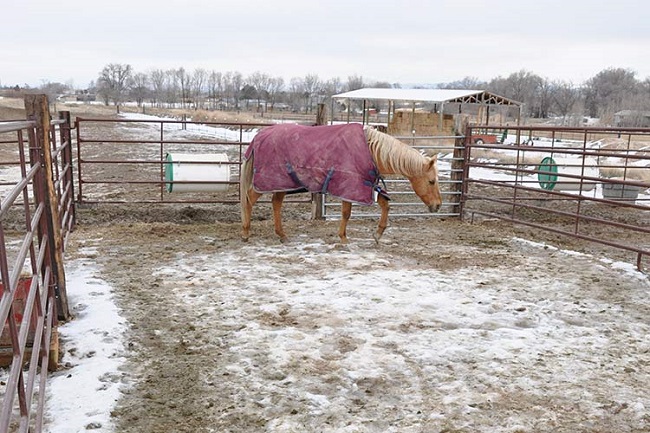
Ice is a problem in horse paddocks as falls and slips can lead to serious injury. The best solution is to remove the horse from the paddock, until the ice melts, but few horse owners have that option. Sand can be helpful to increase traction. However, it is ideal to not feed the horses in the area where the sand is spread to minimize the risk of ingestion. Straight salt can speed the melting of the ice if temperatures are not too cold.
There is no research documenting the effect of salt on horse hooves, but pure salt should be used in moderation as a precaution. If using pure salt to melt ice, make sure the horses have an alternative source of salt to reduce ingestion off the ground. A mixture of sand and salt should not be used in horse paddocks due to the chance of horses accidentally ingesting the sand via their interest in the salt.
Other options like shavings, hay, and straw tend to slide over ice and do not provide additional traction. Small rocks can provide traction but can be accidentally ingested or become lodged in hooves. To reduce water and ice buildup in the future, improve the grade, install gutters on the barn, and reduce the amount of manure in the paddock.
Provided by Julie Wilson, DVM and Erin Malone, DVM, University of Minnesota College of Veterinary Medicine.
Did You Know
The longest recorded flight of a chicken was thirteen seconds.
Cats have 32 muscles in each ear.
Fleas can jump 350 times their own body length.
Octopi have gardens.
Crows have the largest cerebral hemispheres, relative to body size, of any avian family.
Crickets hear through their knees.
Pigs, walruses, and light-colored horses can get sunburned.
Related Articles & Free Email Newsletter Subscription
2 Easy and Inexpensive Horse Care Ideas
The Extraordinary Way That a Horse Sees
Why Positive Reinforcement is More Effective in Training Horses




Comment here